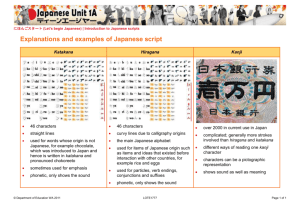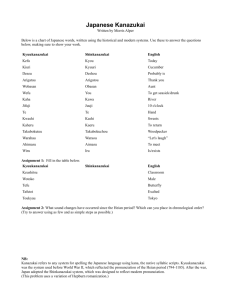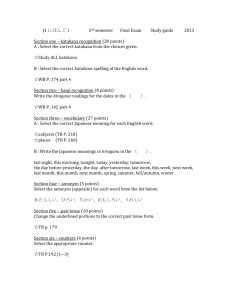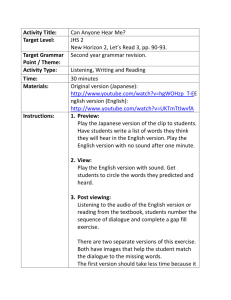Chabot College
advertisement
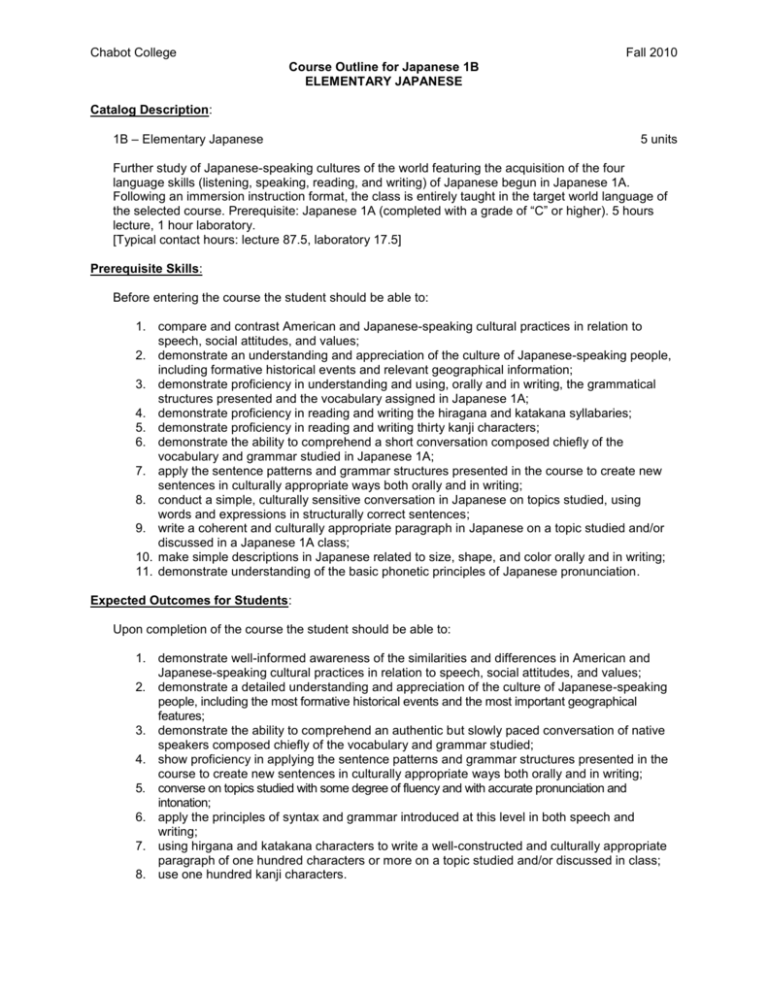
Chabot College Fall 2010 Course Outline for Japanese 1B ELEMENTARY JAPANESE Catalog Description: 1B – Elementary Japanese 5 units Further study of Japanese-speaking cultures of the world featuring the acquisition of the four language skills (listening, speaking, reading, and writing) of Japanese begun in Japanese 1A. Following an immersion instruction format, the class is entirely taught in the target world language of the selected course. Prerequisite: Japanese 1A (completed with a grade of “C” or higher). 5 hours lecture, 1 hour laboratory. [Typical contact hours: lecture 87.5, laboratory 17.5] Prerequisite Skills: Before entering the course the student should be able to: 1. compare and contrast American and Japanese-speaking cultural practices in relation to speech, social attitudes, and values; 2. demonstrate an understanding and appreciation of the culture of Japanese-speaking people, including formative historical events and relevant geographical information; 3. demonstrate proficiency in understanding and using, orally and in writing, the grammatical structures presented and the vocabulary assigned in Japanese 1A; 4. demonstrate proficiency in reading and writing the hiragana and katakana syllabaries; 5. demonstrate proficiency in reading and writing thirty kanji characters; 6. demonstrate the ability to comprehend a short conversation composed chiefly of the vocabulary and grammar studied in Japanese 1A; 7. apply the sentence patterns and grammar structures presented in the course to create new sentences in culturally appropriate ways both orally and in writing; 8. conduct a simple, culturally sensitive conversation in Japanese on topics studied, using words and expressions in structurally correct sentences; 9. write a coherent and culturally appropriate paragraph in Japanese on a topic studied and/or discussed in a Japanese 1A class; 10. make simple descriptions in Japanese related to size, shape, and color orally and in writing; 11. demonstrate understanding of the basic phonetic principles of Japanese pronunciation. Expected Outcomes for Students: Upon completion of the course the student should be able to: 1. demonstrate well-informed awareness of the similarities and differences in American and Japanese-speaking cultural practices in relation to speech, social attitudes, and values; 2. demonstrate a detailed understanding and appreciation of the culture of Japanese-speaking people, including the most formative historical events and the most important geographical features; 3. demonstrate the ability to comprehend an authentic but slowly paced conversation of native speakers composed chiefly of the vocabulary and grammar studied; 4. show proficiency in applying the sentence patterns and grammar structures presented in the course to create new sentences in culturally appropriate ways both orally and in writing; 5. converse on topics studied with some degree of fluency and with accurate pronunciation and intonation; 6. apply the principles of syntax and grammar introduced at this level in both speech and writing; 7. using hirgana and katakana characters to write a well-constructed and culturally appropriate paragraph of one hundred characters or more on a topic studied and/or discussed in class; 8. use one hundred kanji characters. Chabot College Course Outline for Japanese 1B, Page 2 Fall 2010 Course Content (Lecture): 1. Review “recycling” and extension of content of Japanese1A, including the addition of seventy kanji characters in writing assignments 2. Development of conversation skills 3. Comparative analysis of Japanese and American cultures 4. Further study of Japanese customs, values, attitudes, relationships, civil institutions, families, geography and history 5. Functional vocabulary and grammar to allow students to: a. extend, accept, or refuse invitations in culturally appropriate ways orally and in writing b. gather and/or request information with a variety of interrogative strategies orally and in writing c. express spatial relationships (far, near, front, back, next to, around, right, left, etc.) d. use culturally authentic maps and timetables e. ask for, read, understand, and write simple street directions f. make purchases in stores and perform transactions in culturally authentic ways g. function successfully in basic cultural interactions that involve buying tickets h. discuss in simple terms their likes and dislikes and inquire in culturally sensitive terms into the likes and dislikes of others orally and in writing i. describe, orally and in writing, simple physical ailments to pharmacists and doctors j. narrate simple events in past, present, and future orally and in writing k. make physical descriptions of people and things orally and in writing l. count, understand, and write numbers, and be sufficiently comfortable with numbers for simple financial transactions in Japanese currency. 6. The following aspects of Japanese grammar: a. Inflective forms of basic verbs (polite and plain forms, present, past, and past negative) b. Variations of the basic particles (de, made, kara, ni, to) c. Constructions of request, volition, permission, and prohibition d. Subordinate clause constructions and quotations (toki, aida, mae, to iu) e. Compound verbs f. Na-nouns 7. Further study of Japanese phonetics for good pronunciation. Course Content (Laboratory): 1. Activate lecture content using interactive audio and audiovisual programs on CDs, DVDs, CD ROMS, target language websites, etc., featuring culturally authentic and contextual guided speaking, reading, and writing activities such as cued repetition of native speech, dictations, cued oral responses, listening comprehension, and interactive realia (culturally authentic texts). 2. Organized laboratory activities including conversation groups. 3. Fundamentals of Japanese writing (hiragana, katanaka, and kanji) and pronunciation: a. Writing and pronunciation of the forty-six hiragana characters b. Writing and pronunciation of katakana characters. c. Japanese phonetics, including voiced and unvoiced consonants, short and long vowels, double consonants, glides, and pitch (high and low) accents d. Writing and pronunciation of the most common kanji characters, including those derived from pictures and symbols Methods of Presentation: 1. 2. 3. 4. curriculum 0910 dk 12/7/09 Lecture/discussion in target language Choral/individual repetition of model speech Re-creation of dialogues and improvisation Small group activities leading to skits, dialogues, etc. Chabot College Course Outline for Japanese 1B, Page 3 Fall 2010 Assignments and Methods of Evaluating Student Progress: 1. Typical Assignments a. Practice kanji characters presented in the textbook b. Personalize textbook stories, modify them creatively, and write the new version using hiragana, katakana, and kanji characters studied c. Prepare a travel itinerary to a famous castle in a central prefecture of Japan, read maps, train information, and timetables, and make a reservation at a minshuki inn. d. Write a composition about a student’s family members or close friends and recite it from memory in front of the class. e. Laboratory assignment: Make a recording of an extract from the Tale of the Genji. 2. Methods of Evaluating Student Progress a. Tests, quizzes, and interviews to evaluate the four language skills in relation to material presented b. Student participation in class activities c. Oral reports (without notes) on Japanese geography, holidays, art, films or an aspect of Japanese popular culture d. Homework assignments e. Recording from the language laboratory to evaluate pronunciation skills. f. Mid-term and final examination Textbook(s) Typical: Yookoso, by Toosaku, Yasuhiko, third edition, McGraw Hill, 2006. Nakama 1 Introductory Japanese: Communication, Culture, Context, second edition, by Yokiko Abe Hatasa, Seiichi Makino, and Kazumi Hatasa, Houghton Mifflin Harcourt Publishing Company: Boston, New York, 2009. Special Student Materials: None curriculum 0910 dk 12/7/09
